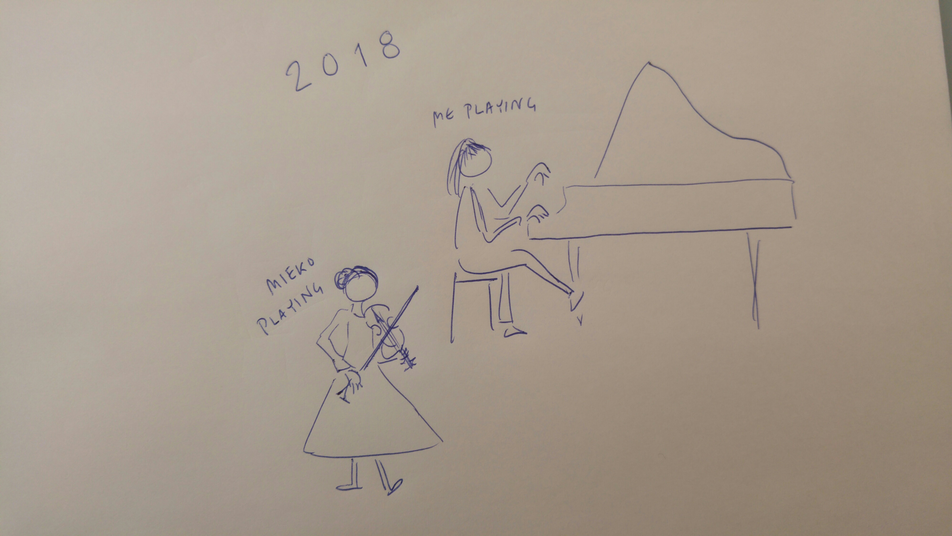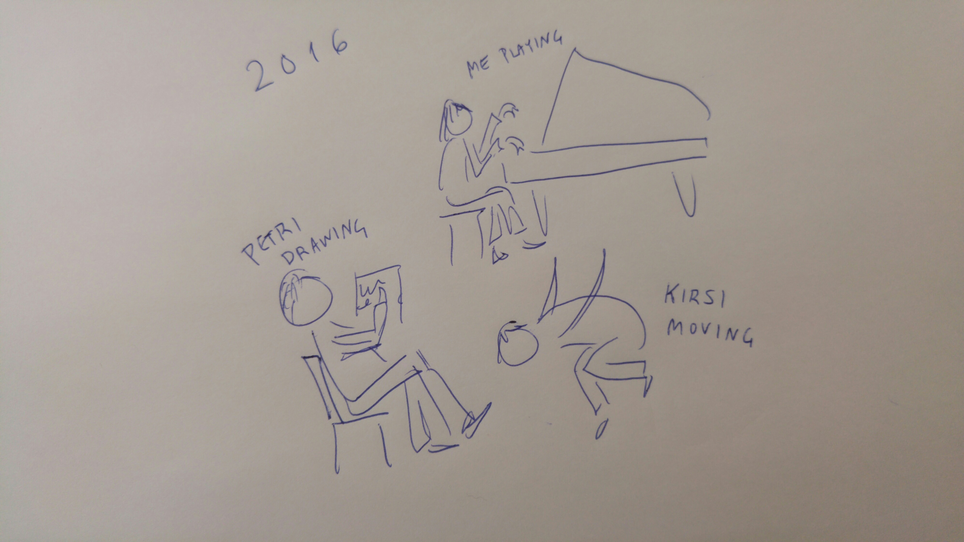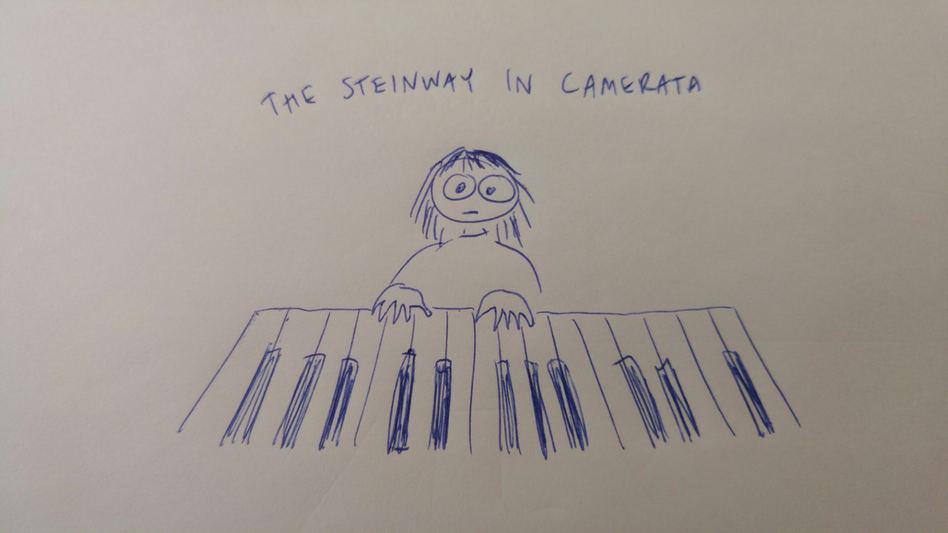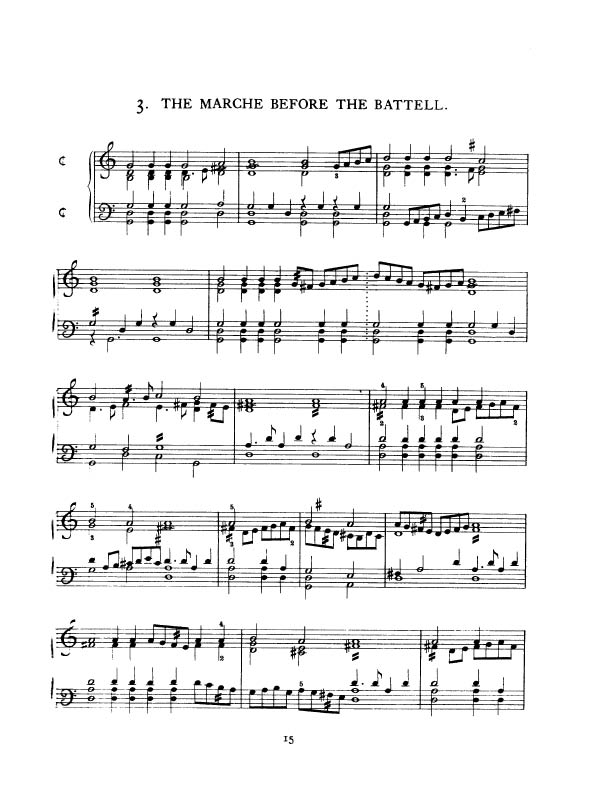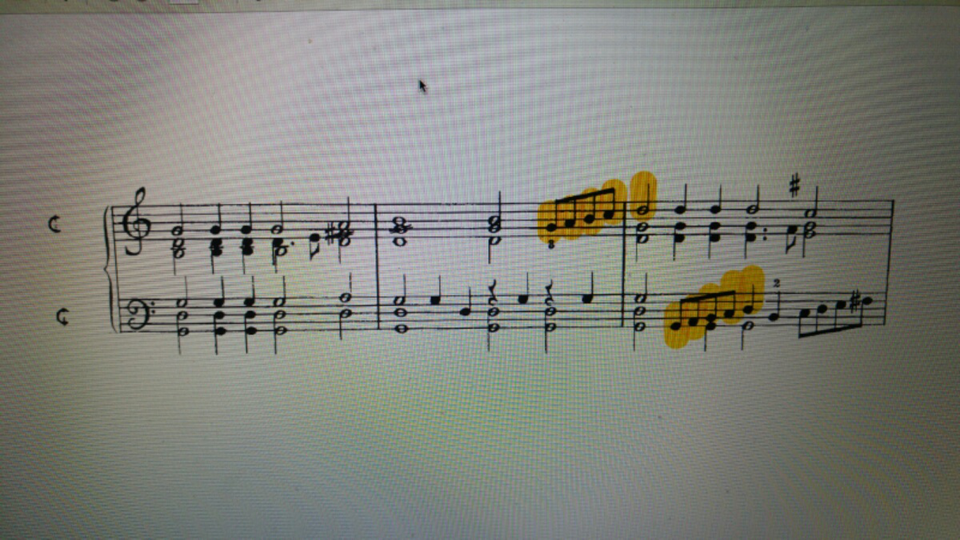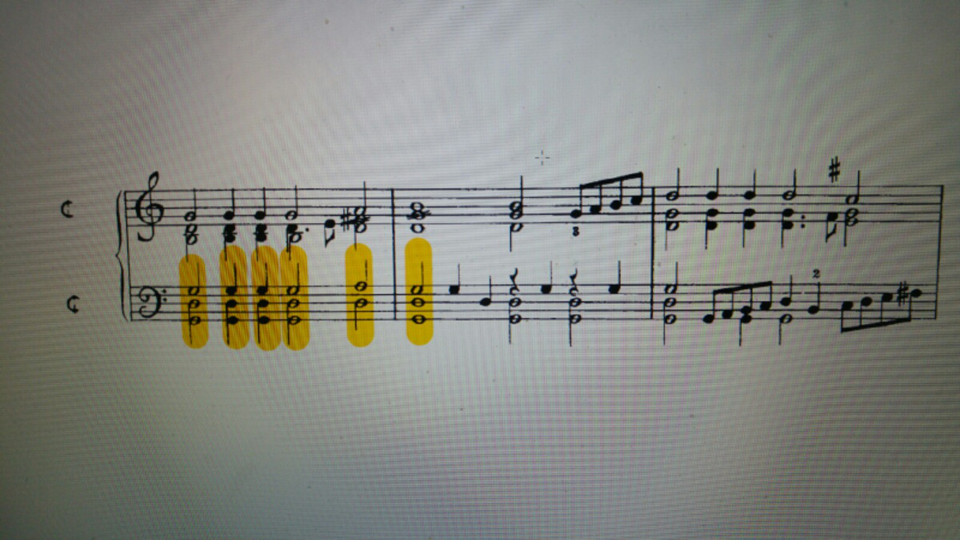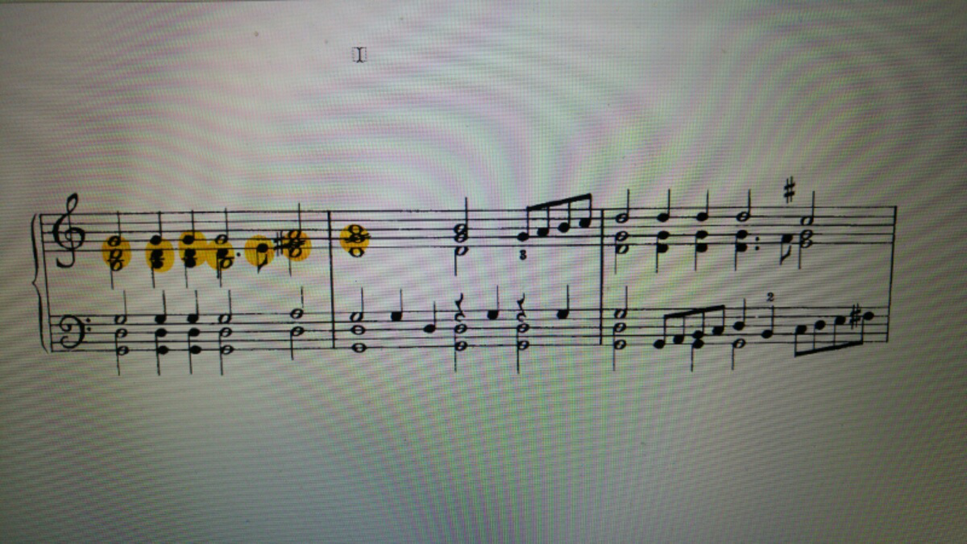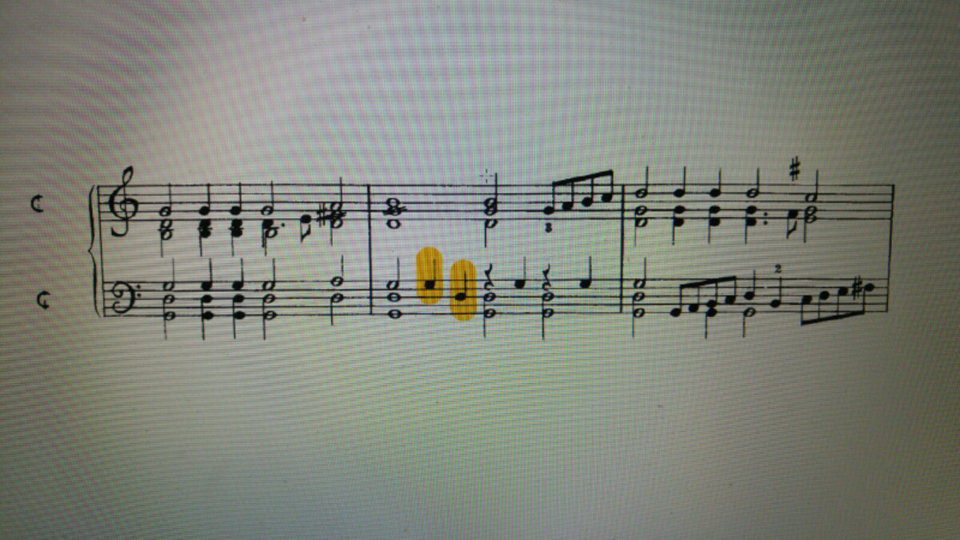I N T R O D U C T I O N
In this exposition, I study the concept of ‘experimentation’ in a violin-piano recital and describe how the praxis of the Silence Ensemble in 2016...
The experimentation in the duo recital took place at both conscious and unintentional levels. The conscious experimentation concerned the interaction with the audience, and this was planned beforehand with my duo partner, violinist Mieko Kanno.
The unintentional experimentation refers only to my own thoughts and actions on the day of the concert: the way I practiced at the concert venue and the way I prepared mentally. Compared to my normal concert preparation routine, I behaved differently, but I didn’t realize it immediately. Rather, I started to interpret my actions as experimentation only afterwards, when I saw the connection between the duo recital and my (then two-year-, now three-year-long) collaboration in the Silence Ensemble (with dancer Kirsi Heimonen, visual artist Petri Kaverma, pianist Anu Vehviläinen). The unintentional experimentation involved primarily my seizing the now-moment before the concert and especially during the very first bars I played at the beginning of the concert.
To explain why I felt I succeeded in the concert, it is necessary to describe the pianistic praxis and the way I worked with the first bars of Byrd’s Marche. The experimentation became incarnate in a very precise technical practice.
The collaboration of the Silence Ensemble is all about experimentation. I see our artistic research as a laboratory, which constantly gives me new ideas and approaches to being a classical pianist. We have written a joint exposition (Heimonen, Kaverma & Vehviläinen 2018) about our experimental research which describes the methods and outcomes we used in 2016–2017.
t h e r e s e a r c h q u e s t i o n s &
t h e s t r u c t u r e o f t h e e x p o s i t i o n
In this exposition, I concentrate specifically on one of the outcomes discussed in Heimonen (et al. 2018): seizing the now-moment. My research questions are:
In what way did the experimental research of the Silence Ensemble influence my actions and experience in the duo recital? How did I experience ‘seizing the now-moment’ in that particular concert?
This exposition is divided into seven chapters. In the chapter the Experimentation within Artistic Research, I discuss the theory behind the concept of experimentation within artistic research and refer to the following writers: Darla Crispin, Bob Gilmore, Godfried-Willem Raes, Kathleen Coessens, Bart Vanhecke, Paulo de Assis. I also describe the collaboration of the Silence Ensemble and the concept of ‘seizing the now-moment’, which I consider relevant for the duo concert.
The chapter Duo Recital Program & Conscious Experimentation describes the overall idea and the program of the duo concert as well as the way we decided to experiment.
The following chapter, Byrd's Challenge, focuses especially on the very first solo keyboard piece of that concert, William Byrd’s The Marche before the Battell. The reader will find out why Byrd's music was challenging for me. I discuss with some pianists-researchers such as Catherine Laws (2014) and Satu Paavola (2018).
My Technical Expertise describes the way that I work with the first bars of Byrd's Marche. Via video excerpts and explanations, the reader will gain an understanding of crucial aspects of my pianistic praxis.
Unintentional Experimentation focuses on my actions before the concert. I consider them to be relevant in discussing the influence of the Silence Ensemble’s praxis on the duo recital. Final remarks are written in the Discussion.
T H E E X P E R I M E N T A T I O N W I T H I N
A R T I S T I C R E S E A R C H
In the area of artistic research in music the concept of ‘experimentation’ has been discussed recently in various studies. Darla Crispin and Bob Gilmore argue that artistic research can be seen nowadays as a potential mode of inquiry, even though clear definitions of artistic research are still difficult, if not impossible, to find. While artistic experimentation differs from scientific experimentation, both are seen as rigorous and exact practices (Crispin & Gilmore 2014, 10). From my point of view, the qualitative depth of artistic research depends quite a lot on the artist-researcher’s willingness to explore his/her own praxis – even the most problematic and unflattering aspects of it.
Godfried-Willem Raes discusses the interrogative and experimental nature of any good research: "An artist who limits him- or herself to craft is like a laboratory technician who uses test tubes, measuring scales, and reactions according to the rules, regulations, and rituals, but does so without asking any questions, to no purpose that is clear to him or her.” Raes sees no fundamental difference between art and science since ‘relevant art’ – as he argues – always poses questions (Raes 2014, 56).
Partly following Raes’s demand for ‘relevant’ art, Kathleen Coessens locates experimentation in the natural creativity of the artist. She sees music-making itself as experimental. Coessens argues, that in spite of all preparation that precedes a classical music concert, there is still room for creativity: a performance always contains unpredictable elements and occasions that lure the performer into creativity. A performer somehow expects the unexpected and is quick to attune himself/herself to whatever may happen during music-making. The unexpected opens gaps for experimentation (Coessens 2014A, 64–66).
Paulo de Assis argues that ‘unfinished thinking’ is the essential engine in artistic research: it guarantees fluidity between thoughts and practices as well as conceptual and artistic approaches. Instead of fixed or conclusive ideas, according to de Assis, artistic research in music has moved from interpretation and representation towards problematisation and experimentation. This implies multiple ways to rethink the performer’s relationship with the musical work (de Assis 2018, 13, 19). In this way of describing the linkage between an interdisciplinary collaboration (2016) and a duo recital (2018), the concept of ‘fluidity’ as suggested by de Assis becomes a necessity.
Within the above-mentioned definitions of the concept of ‘experimentation’, there seem to be clear differences. Some researchers believe that experimentation is always an essential part of art and music-making, while others seek clearly new inventions and approaches. Raes distinguishes between two extremes: music-making that poses questions vs. monotonous and repetitive art (which might not be seen as art in the first place), while Coessens states that the creative part of music-making is inherently experimental. For de Assis, experimentation seeks novelty and can be seen as a modern continuum of the established idea of interpretation.
To clarify the topic of this exposition, I find composer Bart Vanhecke’s thinking – akin to de Assis’ ideas – the most adequate. Vanhecke distinguishes among three kinds of experimentation related to art: experimentation for, in and through art. He defines experimentation for art to be scientific and not actually artistic at all, whereas experimentation through art means experimentation that happens through artistic practice and expression. Experimentation in art refers to artistic exploration which involves new kinds of knowledge or new types of exploration – a way for artists to expand their aesthetic universe (Vanhecke 2014, 95–96).
Vanhecke sees the artist’s aesthetic universe as a large web of different concepts and understandings. It encompasses the theoretical and historical knowledge of music and repertoire, as well as the procedural knowledge to play an instrument, read scores and compose a new piece of music – but also all of the emotional traces that are left in the musician’s brain by aesthetic experiences. Compositions and performances are hence “the expression of the complete meaning of aesthetic concepts–aesthetic ideas–within his or her aesthetic universe”. Meanings can be conceptual or non-conceptual and intuitive since there are ideas that cannot be expressed verbally (Vanhecke 2014, 92).
For Vanhecke, ‘culture’ refers to the way artists share common aesthetic knowledge with other people. To operate at the borders of the prevailing culture is to question it and to explore new ideas. The way an artist consciously and deliberately explores his/her aesthetic universe can be understood as artistic research (Vanhecke 2914, 93–94). Vanhecke (ibid. 94) points out that “since artists are the only ones who have unmediated, direct access to their own aesthetic universe, artistic research can only be performed by those artists themselves.”
For Vanhecke, experimentation through and in art are both ways to explore within the artistic aesthetic universe. The former (through) refers to the creation of new forms of artistic expression, the outcome of which is experimental and innovative music. It represents bottom-up experimentation, starting from artistic practice and ending in the creation of new aesthetic ideas. The latter (in) is about ‘thought experiments’ happening mostly in the cerebral universe, rather than experimentation, performed in the physical world. Experimentation in art consists of new laws in dealing with one’s aesthetic universe as well as in assessing one’s relation to the external world. The outcomes of experimentation in art are abstract experimental ideas and tools. Compared to experimentation through art, Vanhecke sees the latter more as top-down experimentation that starts from an abstract – and as far as I can see, probably more intellectual – area of developing new ideas, to be implemented later in practice (Vanhecke 2014, 95–97).
For me, the boldness of the experimentation depends on the point of view of the person evaluating it. I suggest that the most challenging task is probably studying ‘tacit experimentation’, i.e. the thoughts and attitudes in the mind of the artist. It is possible that the audience or even fellow artists can be unaware that any experimentation is even taking place. Hence, the only evidence thereof is the testimony and description that the artist is able to offer about his/her individual experiences.
An example of tacit experimentation is the way a musician prepares for a concert. While visible and seemingly drastic actions can be interpreted as experimentation, preparation is mostly about dealing with and bearing one’s own thoughts. Kathleen Coessens discusses the same problem, arguing that the artist’s expertise is tied to a complex domain of (partly tacit) knowledge, experience and actions, which are difficult to trace and which can only be made visible by either theorizing or by the introspection and interpretation of the artist (Coessens 2014B, 69).
Päivi Järviö’s study on the experience of a singer of Early Italian Baroque Music also discusses introspection as method, which Järviö finds the most suitable in dealing with her research topic. Järviö recognizes several possible methods of collecting data on other people’s experiences, but as good as they may be, these methods nevertheless ignore the experience of any one living individual. Ultimately, such generalizations about experiences would then lead to an experience that belongs to nobody (Järviö 2011, 40, 107).
I find introspection within artistic research necessary as well as rewarding. I agree with Järviö on the notion that the introspection of one living individual brings forth special and detailed knowledge. The researcher's responsibility is to be as detailed, open and honest as possible so that the described experience can be perceived by the reader.
t h e e x p e r i m e n t a t i o n o f t h e s i l e n c e e n s e m b l e
The interdisciplinary praxis of the Silence Ensemble can be seen as an example of artistic experimentation. In 2015, dancer Kirsi Heimonen invited me as well as visual artist Petri Kaverma to study the notion of ‘silence’. We, the Silence Ensemble, combine movement, sound and visuality in a project that has provided common ground for all three art forms, and has paved the way for experimental and cross-border cooperation. That very praxis has been at the centre since the beginning. We have found a fresh perspective on the practices of our own art genres and, on the other hand, we have encouraged each other to find new ways of making art.
In the spring of 2016, we organized seven two-hour sessions during which our three art forms productively collided: I played the piano, Heimonen moved and Kaverma drew and shot videos. This experimental praxis was analysed and discussed thoroughly in 2017 and led to a published exposition where our methods and outcomes are described in detail.
The outcome, the most relevant aspect for this exposition, deals with my ‘capturing the now-moment’. It had a strong physical-spatial flavour. For years – if not for decades – I had mainly experienced piano playing as something that happens in a non-spatial, mental bubble which encompasses the idea of a keyboard, the musical work and my mind. But the physical action of a dancer (dancing behind my back) forced me to sense the physical reality of the space in which we were carrying out our praxis. During our sessions, instead of just sitting at the piano, I also started to walk around the space, to feel and experience and somehow own the room. I understand my physical explorations in the 2016 sessions as a very concrete way to seize the now-moment: I’m here, in this room, with these people and these objects. The experience was also a very visual one: in the sessions, I was using my vision much more than usual when playing the piano. The objects around me roused my interest.
The most surprising manifestation of “seizing the now-moment” was that I started to improvise in our sessions, despite having declared at the beginning of the first session that I would not improvise, since that isn’t my genre and I wanted to be me in our project. But the atmosphere and the mutual, beautiful trust worked in a way that lured me into trying out improvisation. That was totally unexpected and unintentional. During the sessions and even afterwards on some other occasions (for instance in conferences), improvising acted as a tool for me to explore the now-moment. Through improvising, I practiced letting go of control and accepting the fact that I didn’t know what is going to happen.
In his dissertation on human-computer interaction, one of musician-composer Henrik Frisk’s outcomes was a radical improvisatory attitude towards all aspects of his musical practice. He sees ‘giving up the Self’ as an essential part of giving up control and heading towards an improvisatory attitude (Frisk 2008, 101). I can easily relate to this notion. I once took a huge risk by improvising at an artistic research conference, when I (with the Silence Ensemble) demonstrated our interdisciplinary praxis live, on stage. Before that demonstration I had improvised probably three times in my whole life and never before a live audience. Hence, my playing didn’t sound very good, but the point was to give up the Self and accept playing at less than my best. My excellence wasn’t the issue as it tends to be in classical music concerts: the issue was seizing the now-moment. I was quite proud of myself.
D U O R E C I T A L P R O G R A M &
C O N C I O U S E X P E R I M E N T A TI O N
The concert took place at the Camerata Hall, Music Centre Helsinki, February 7, 2018. The theme of our program was "Simple or Complex?" which discussed how this dichotomy in music-making actually manifests itself. This is the concert program.
Mieko and I wanted to enhance the silences between the musical works/pieces; hence, I made two experimental suggestions:
1) we would ask the audience not to applaud during the concert and
2) we would be sitting on the stage already when the audience came in.
These actions would (we hoped) deepen the intimacy of the moment as well as the connection between the audience and ourselves. I had written my suggestion about "no applause" into the program notes, and before the concert started, Mieko and I were already on the stage waiting for the audience. We saw the listeners showing up one by one, not as one single mass but as individuals. Everyone entering the hall accepted our invitation of silence at the beginning of the concert. There was no applause, but rather a shared, intimate and silent moment before I started to play the first solo piece, Byrd's Marche before the Battell. Not until after the last piece, Szymanowski's Tarantella, did the audience applaud for us. That shared focus on music without cutting it here and there with the sound of clapping was amazing.
Byrd’s The Marche before the Battell starts with four G-major chords which establish the rhythmic character for the whole piece.
In describing my practice of the rhythm, I first need to talk about the touch of my fingertips. Without the right and controlled touch in my fingers, I am unable to control the rhythmic elements of the music and the overall musical breathing. The innocent little chords by Byrd made me go deep into the very roots of my piano technique. I learned the apparently simple music quite fast (compared to Szymanowski’s complex harmonic layout, for instance), but I had a lot of trouble in making the texture breathe and “dance”. I felt intuitively that this march should be played with a lively yet rigorous style which would not prevent the Englishmen from marching boldly against the Irish (and vice versa).
For me, finding the right touch, the physical action is about an anticipatory gesture:
If I want to play an entity (such as a chord or a single tone) without using too much energy from my arms and hands, I need to feel that entity in my fingers before I play it. That’s all there is to it. Pianist Satu Paavola uses the term ‘initiatory gesture’ when referring to actions before pressing the key; she sees initiatory gestures as essential, if not the most important part of piano playing (Paavola 2018, 79).
I understand the anticipatory gesture in two main ways. Firstly, anticipating means that I place the finger clearly on the key before I press it (see also Paavola 2018, 80). As soon as the finger has pressed one key, it is immediately and as fast as possible placed on the surface of the next key so as not to lose energy in moving the finger between two different keys. I discussed this technical aspect in my doctoral thesis (Vehviläinen 2008, 51). It is also very easy to demonstrate. (See the video below, in which I do not deal with the arm or wrist or anything else that might be necessary to use the fingers in the first place. The focus is solely on how the finger moves fast from one key to another.)
B Y R D ' S C H A L L E N G E
To more effectively discuss the unintentional experimentation that took place, I first describe two issues: my actions before the concert as well as my own experience of the music that I played during the duo recital. Furthermore, I have chosen to present a deeper rather than broader analysis of the program; to that end, I focus only on the first bars of the first piece of music, William Byrd’s The Marche before the Battell.
Playing early music on a modern grand piano was a type of experimentation that I gladly allowed myself; while I have no experience on period instruments, I see no problem playing whatever I want in my own concerts. Practicing Byrd’s music, however, turned out to be an ear-opening and extremely challenging experience, mostly because I’ve spent the last two decades on Karol Szymanowski’s Late-Romantic, dense, complex and multi-layered music.
Whereas Szymanowski has forced me to focus on sound balance, Byrd challenges me with his dance-like rhythm.
Pianist Catherine Laws discusses the status of sound in Morton Feldman’s piano music. Referring to Charles Rosen, Laws argues that very often composers assume a uniformity of tone colour across the piano, even though in reality in the lowest and highest regions, most pianos have very different colours; just as in the piano repertoire in general, sound seems to be subordinate to other parameters, such as form and structure (Charles Rosen 2004, 45, 50 in Laws 2014, 282). On the other hand, Laws argues that it is precisely Feldman’s piano music that encourages pianists to focus on the tiniest details and differences in sound (Laws 2014, 282-283).
Whereas Laws sees sonority as the musical parameter that requires the most attention from pianists, my blind spot has always been rhythm. I blame Szymanowski and his layered textures: his scores make me want to hear the tiniest details so that the soundscape avoids getting blurry, instead shining transparently and brilliantly. At the same time, I tend to ignore a bit the rhythmical aspects. The texture is moulded out of several harmonic and melodic layers, and figuring out how that material should be balanced requires a lot of effort. I would also argue that the sound needs to be put front and centre in Szymanowski’s music. Perhaps I am just what Laws (above) calls for: a pianist who focuses above all on the tiniest details and differences in sound. In contrast, Byrd will not let me be negligent with the rhythm.
Here is the first page of the Marche of William Byrd's Battell.
p l a c i n g t h e f i n g e r s v e r y f a s t A
Playing a G major scale, placing fingers as fast as possible on the following key.
p l a c i n g t h e f i n g e r s v e r y f a s t B
In the next excerpt, I demonstrate how I play tones that are very far apart on the keyboard. The point is to show that the finger goes immediately to the next key. The tempo is slow but the fingers move really fast, without losing energy or time between two tones. As soon as I have played one tone, I immediately think about the next tone (and their respective fingers).
The other way of perceiving the anticipatory gesture is about the moment before the finger is on the surface of the key. Explaining this is a bit more difficult.
As understood from Paavola’s writing, that moment (before a pianist touches a key) entails almost everything the pianist has learned during her/his life as a pianist. Paavola argues that the actions of placing the finger on a key and using soft movements in the arms and wrists are somewhat automatic actions. Paavola goes much further, however, in studying which phenomena qualify as initiatory gestures. For Paavola, mental images and proprioceptive understanding help the pianist in moulding the expression (Paavola 78–83). Mental images alone could be the focus of several articles.
Rather, I describe what kind of thoughts come to mind when I succeed in finding a suitable physical-mental condition, a particular feeling of anticipation and the right touch in my fingertips. In the following I use videos as well as excerpts from the score to demonstrate.
"t h e l e f t h a n d g a t e"
The first chords on the left hand are not problematic, but as soon as there is any melodic activity in the lower stave, I need to focus on my left-hand fingers. If I don’t manage to give extra focus to my left thumb, it will stay passive and dependent, since it’s the right hand which naturally dominates and captures my focus – unless I challenge it. All left-hand-focus needs extra attention. I therefore work hard to remember that the G, played by my left thumb, and the D which follows (played by my left index finger), need extra focus. I’ve often practiced thinking about my left thumb before I press the G. In fact, I’ve stopped the music before the G to ask myself whether I’m really thinking about my thumb or not.
M Y T E C H N I C A L E X P E R T I S E
t h e b e g i n n i n g
Let us start by thinking about the beginning of the piece with the G major chord. Even if I don't play period instruments, I have a harpsichordish sound in mind: a crispy, airy and rapid sound, as I imagine a harpsichord would sound.
For me, an essential part of music-making is abstract visual forms (Vehviläinen 2008, 58). The different positions of the hands on the keyboard blend in the score markings (chords, patterns, figures) as well as distances between two units (e.g. two chords played one after another). For me, Byrd's first G major chord is like an arc between my little fingers. I therefore think about an abstraction of an arc before I play the chord.
The visualization of my arc changes slightly due to the harmonic balance. The most natural – and very pianistic – way to balance the chord would be to play the base and the soprano a bit louder than the other tones. But in this case, I want to emphasize the alto voice (the D played by the right-hand index finger, the second highest tone of the first chord), since I find it more interesting and active. I therefore need to work with the index finger of the right hand since it begins the alto melody. In the video excerpt, I show different ways to balance the first chord: first emphasizing the little fingers (base and soprano), then thumbs and finally, the index fingers. The sound changes respectively.
The idea of emphasizing the alto voice makes the beginning a bit tricky. I need to search for the right physical touch in my palm and fingers to be able to play the D louder than the highest G, not to mention the joy this kind of physical work gives me. I could spend hours searching for the ideal balance and leave everything else open.
t h e i n d e p e n d e n t f i n g e r s &
t h e a n t i c i p a t i o n
I want my fingers to feel vigorous and active, independent. To find independence, I have thought about each of the six fingers that are going to play the first chord. When I think about one specific finger, I feel the energy going to the fingertip. I own the finger. I have concentrated on and looked at the fingers one by one, separately. I need to focus on every single finger and fingertip to be sure that I really feel them. If I don’t put extra focus on some of the fingers, there will be more dominant ones and weaker ones. The right hand tends to be very dominant and strong, whereas the fourth and the fifth finger of the left hand are weaker.
The following video is probably the best at showing the anticipation I've tried to describe. As the hands rise into the air, one can see the "grasping" and active feeling of the fingers, ready to touch the right keys right afterwards.
s p e n d i n g t i m e o n f i n d i n g t h e r i g h t t o u c h
a n d b a l a n c e f o r t h e f i r s t c h o r d
t h e a l t o v o i c e o n t h e r i g h t h a n d
In this excerpt, I demonstrate how it would be easy to emphasize the soprano (the highest voice on the right hand, beginning with the G), but instead, I want to hear the alto voice (beginning with the D) in the middle of the texture. I need to work with the index finger of the right hand, since it begins the alto melody. Also, I need to be careful to not completely lose the soprano, since the balance would be somewhat fragile and peculiar without any support from the soprano voice. I play the soprano and alto voices separately to internalize them well.
t h e l e f t - h a n d q u a v e r s
The quavers on the left hand are crucial since they are the first fast notes on the left hand. This pattern echoes something that happens first in the right-hand material, which starts with the weak fingers (fifth and fourth fingers of the left hand), so again, extra focus is needed.
t h i s i s h o w I o f t e n p r a c t i c e
In the last excerpt of this chapter, I demonstrate the way I really like to practice: I stop every now and then, focus on certain issues, prolong some chords or individual tones and so on. I present two different versions: the "practicing" and "how it really should sound".
When I pay extra attention to the left-hand quavers, my eyes are also focused on the keyboard and my head is leaning forward, eyes staring at the particular keys I'm supposed to press and at the fingers pressing them.
This kind of "slow-motion playing" makes me hear more. I feel that I'm in control of the whole texture, free to emphasize whatever I choose.
d i f f e r e n t p o s i t i o n s o f t h e h a n d s o n t h e
k e y b o a r d a r e a p a r t o f t h e a b s t r a c t
v i s u a l f o r m s.
p r o l o n g i n g t h e d u r a t i o n o f
s o m e o f t h e c h o r d s
The result of finding the touch in the fingertips is that I'm able to breathe and mould phrases freely. Since I'm not worrying about single tones (and I'm able to play them in rhythm), I naturally hear the long chords (e.g. all the half notes) and spaces between two phrases until the end.
Usually, when there are problems with focusing the touch of the fingers, it simultaneously affects natural breathing. It's easier to focus on the beginning than the end of almost anything. Listen to the thing until it's really finished; don't rush!" is a common refrain in piano lessons. The fermata can be almost any length if the performer is focussed and convincing enough to listen to it. Very often in children's concerts, it happens that the music is performed well, but the young performer stands up from the piano chair while the last chord is still audible, not really listening until the end. The meaning of pauses is discussed by Laws.
In the next excerpt, I prolong some chords to avoid rushing and precipitating, which happens especially often in live situations.
U N I N T E N T I O N A L E X P E R I M E N T A T I O N
The following description opens up my preparation before the concert. Interpreting it as experimentation – influenced by the praxis of the Silence Ensemble – only happened in retrospect, mostly when I began writing this exposition.
Mieko and I started to rehearse in the hall two hours before the concert began. I had a problem with the Steinway grand piano, which at the Camerata Hall is extremely heavy. When I pressed a key, I felt that I was dealing with a tractor, not a delicate and smooth instrument. So I needed to work alone with the piano to find the right touch.
Mieko was joyful and easy-going; she didn’t want to practice too much. Instead, she decided to do sudokus backstage, so I had some time to concentrate by myself.
I found myself looking at the spatial elements of the hall: the ceiling, the seating area, the instrument from a different angle. I also took some time to move around the hall: just a few steps during which I concentrated on nothing more than just experiencing the physical space. The thought came to me – I’m allowed to be here. The stage fear and hesitation felt different as I saw the grand piano from a distance, smaller somehow.
The few minutes I spent alone at the piano were crucial.
I played the beginning of William Byrd’s Marche, the first piece of the program. I also played the beginning of Janáček’s Sonata for Violin and Piano. The result was that my arms got tired and I lost the finest control of my fingers. Maybe the audience would not have heard any difference, but I did. I knew how it should feel when everything is in place.
So I sat there and persuaded myself to find the right touch. I worked psychologically with myself to avoid the temptation to go to the dark side which means the pulling rug out from under my own feet just before the concert. Usually I wonder whether I have practiced enough. Also, in almost every concert, I sacrifice the first pieces to anxiety, which entails hurrying the tempo and not giving enough time to the pauses. The anxiety usually makes me rush just to get the stressful concert situation over with sooner. Unfortunately, that means that I don’t find the tiniest possibility to be in the now-moment: I’m worrying about the next moment too much.
In this case though, I found the beauty of the now-moment, seizing it, facing and calmly accepting the situation I was in. I was at the concert hall waiting for the concert to begin, but I still had some time to work – to work in the right way. Instead of hastening my thoughts or thinking of the concert program as one enormous whole, I focused on the beginnings of Byrd’s and Janáček’s pieces.
I was able to perceive my emerging negative thoughts and to think about an alternative solution.
I did the following things:
I assured myself that I knew how to play Byrd and Janáček. I just needed to find the right touch on that particular grand piano.
I accepted the fact that instead of giving up, I would need to work a bit.
I understood that I would not need several hours to find my skills – a few minutes would be enough.
I assured myself that I had the expertise and time I needed.
I also needed to accept that I would not follow my old habits, where I repeatedly sacrificed the first bars of the concert in my haste.
So I practiced the first bars of Byrd’s and Janáček’s pieces until I found the light touch in my fingers. I worked with the anticipation described before. The anticipatory approach gave me a feeling of possessing the musical texture. I felt that the control was in my fingertips, and this offered me the possibility to be free elsewhere. I didn't have to concentrate on technique; I was somehow ahead of the music, so I was able to breathe freely and play (as in child's play) with the musical material.
After a few minutes I knew that I had it. I had found the right touch. I felt relieved and hopped backstage to meet Mieko. The dark clouds were gone, and I couldn't wait to start the concert. We walked on stage to wait for the audience.
The spatial experience expanded from the stage to the seating area as the audience started to flow in. They came in quietly, accepting our invitation not to applaud us. Because we were watching the audience filing in one by one (instead facing them all at once, as a whole crowd), a new and refreshing experience emerged: the balance between each individual listener and myself felt more intimate and equal. I felt that I was about to focus on the music with individual listeners, together. The need for excellence and perfection lost its power, since the idea of the audience as a threatening crowd had completely faded away.
When I started to play, I knew that I was able to be present. I was nowhere else but there, in that moment, with Mieko and those listeners.
The technical touch in my fingertips was there already, and the goodwill of the audience was palpable.
I allowed myself to think good thoughts.
So I played the first tones of Byrd’s Marche.
I played it in absolutely no rush, with enough breathing and focussing on the expression.
I felt truly happy.
D I S C U S S I O N
I have explored the concept of experimentation within one particular case, a duo recital by violinist Mieko Kanno and myself. I asked the question, how did the experimental research of the Silence Ensemble influence my actions and experience in the duo recital? And how did I experience “seizing the now-moment”? I suggested that the duo recital was experimental in two ways.
Firstly, some experimental ideas were conscious; my colleague and I had decided beforehand to sit on the stage as the audience entered the concert hall. Usually in classical concerts, the performers wait backstage until the audience is seated. Also, I wrote program notes which encouraged the audience not to applaud at the beginning of the concert nor in the middle of the pieces. I assume that without my deliberate request, the audience would have applauded at every occasion.
Secondly, as I started to reflect on my experiences after the concert, I understood that our duo recital might have been influenced by the collaboration of the Silence Ensemble. This unintentional experimentation dealt mostly with seizing the now-moment.
According to recent studies on artistic experimentation in music, I find a good many of these approaches adequate and close to my own artisthood. As suggested by Coessens and Raes, I find music-making to be creative, spontaneous and sometimes even a surprising activity in spite of all the detailed preparation. The beauty of live art is that anything can happen – a hint of danger is always in the air. But in this particular case, defining the influential relationship between the praxis of the Silence Ensemble and the duo recital, I feel a special closeness to Vanhecke’s definitions of experimentation in and through art. They help me to articulate this new phase of my artistic growth.
Compared to all of my previous concerts, there were several things that I did differently this time – whether they were conscious or unconscious. The result was that during the very first bars of the concert, I felt better than ever before. For me, that tiny moment was meaningful and important, and it makes me seek other novelties in my praxis, to experiment more.
For me waiting for the audience to walk in one by one was a positive experience. It made me feel a closeness with the listeners, as did the silence between the pieces, which created a holistic experience of the whole concert program. I also described how I took some time to walk around the stage and to use my eyes consciously: What does it look like in here? How does the grand piano look from the other end of the hall? It may be the mildest kind of experimentation one can imagine – just a few small steps – but it created a clear distance from the heavy anxiety at the piano. This physical-spatial experimentation made me feel more rooted in the now-moment.
The most meaningful moment was when I faced the difficulties with the instrument but chose not to panic or give up. I had a choice. Realizing that was a powerful experience that spurred me to do something I wouldn’t normally do. My interpretation is that the vivid experimentation with the now-moment with the Silence Ensemble had paved the way for my positive reaction in the duo recital. I had already grasped a bit of the idea of seizing the now-moment by having practiced it in some unsatisfying situations (improvising poorly in conferences, for example) as well as in safe circumstances (in the praxis sessions with my colleagues from the Silence Ensemble). These experiences had taught me that seizing the now-moment is something I could actually practice. It is something that can help me in stressful situations. It can help me to play the piano better.
The experimentation with the Silence Ensemble shook my concept of being a ‘classical pianist’. By using movement and improvisation, I found myself exploring the ‘now-moment’, which took another form in the duo recital two years later. Apart from our intentional experimentation with the audience, that concert was supposed to be traditional, and, as Vanhecke suggests – representative of a ‘shared culture’ with commonly accepted aesthetic ideas. But it turned out that I unconsciously went further, to explore the borders of my aesthetic universe. A few moments before the concert was about to start, I found myself exploring the now-moment both as a physical-spatial experience as well as ‘in the flesh’, in my pianistic praxis. I suggest that my exploration can be seen as an amalgam of Vanhecke’s experimentation in and through art. While the idea of the ‘now-moment’ gradually started to change my artisthood, it was put into action in my concrete behavior before the duo recital.
As I said above, whether my experimentation was courageous or timid depends on who is making the assessment. The audience may not have noticed any difference in my playing during those first bars. How could they notice anything – to what could they compare my playing? The reader may think that neither sitting on the stage while the audience walked in, nor the shared silence during the concert program was any big deal. Let alone the way I sat down to find the right, light touch of the fingertips instead of giving up. On a professional level, oftentimes it is only the performer him/herself who notices whether everything is in place or not. As Vanhecke (2014, 98) puts it: “What is an experiment for one artist (…) may not be experimental for another.” Only I was aware that I found confidence that I had hardly ever felt before at the beginnings of my concerts. Even if I hadn’t found it, I probably still would have played Byrd’s Marche relatively well, maybe with a little bit of rushing every now and then, but nevertheless on a professional level.
Very often, when we, the musicians, want to conceptualize our artistic processes and thinking, too often we tend to be shy. Our self-censorship prevents us from digging in to our own artistic reality – even though our embodied knowledge is acquired over decades. We might feel that what we find to be relevant may not be important or interesting to others. For me, the clearest evidence to start studying my duo recital was my own emotion, the happiness and the joy I felt. It prompted me to write this article and has spurred me to push on with my own exploration.
S O U R C E S
Cobussen, Marcel 2019. The Intruder. On Differentiations in Musical Research.
https://www.academia.edu/1040039/The_Intruder._On_Differentiations_in_Artistic_Research
Coessens, Kathleen 2014A. Tiny Moments of Experimentation: Kairos in the Liminal Space of Performance. In Artistic Experimentation in Music. Edited by Darla Crispin & Bob Gilmore.
Coessens, Kathleen 2014B. The Web of Artistic Practice: A Background for Experimentation. In Artistic Experimentation in Music. Edited by Darla Crispin & Bob Gilmore.
Crispin, Darla & Gilmore, Bob (ed.) 2014. Artistic Experimentation in Music. Ghent: Orpheus Institute Series.
De Assis, Paulo 2018. Logic of Experimentation. Rethinking Music Performance through Artistic Research. Leuven University Press.
http://oapen.org/search?identifier=1001749
Frisk, Henrik 2008. Improvisation, Computers, and Interaction: Rethinking Human-Computer Interaction Through Music. Malmö: Malmö Academy of Music.
Fräki, Sonja 2016. Toistuvat toccatat – Kalevi Ahon Pianokonsertto nro 1 [Recurring Toccatas – Kalevi Aho’s Piano Concerto Nr. 1]. Helsinki: Sibelius Academy.
Heimonen, Kirsi & Kaverma, Petri & Vehviläinen, Anu 2018. Silence Ensemble. RUUKKU vol. 8.
IMSLP. The Battell (Byrd, William).
http://www.imslp.org/wiki/The_Battell_(Byrd,_William)
Järviö, Päivi. 2011. vi Järviö 2011. A Singer’s Sprezzatura – A Phenomenological Study on Speaking in Tones of Italian Early Baroque Music. [Laulajan sprezzatura – Fenomenologinen tutkimus italialaisen varhaisbarokin musiikin laulaen puhumisesta.] Acta musicologica fennica 29. Helsinki: The Finnish Musicological Society.
Karakorpi, Tiina 2016. Pohdintoja soivilta kehiltä. Soittajan emansipaatio [Thoughts from the Sounding Circles. An Instrumentalist’s Emancipation]. Helsinki: Sibelius Academy.
Laws, Catherine 2014. Embodiment and Gesture in Performance: Practice-led Perspectives. Crispin, Darla & Gilmore, Bob (ed.) 2014. Artistic Experimentation in Music. Ghent: Orpheus Institute Series. 131-141.
Paavola, Satu 2018. Ihanteena bel canto. Näkökulmia laululliseen pianonsoittoon [Ideals of Bel Canto Applied to the Piano]. EST publishing series 43. Helsinki: Sibelius Academy of the Uniarts of the Helsinki.
Raes, Godfried-Willem. Experimental Art as Research 2014. In Crispin, Darla & Gilmore, Bob (ed.) 2014. Artistic Experimentation in Music 2014. An Anthology. Edited by Darla Crispin and Bob Gilmore. Leuven University Press. 55-59.
The Image of Irelande, with a Discoverie of Woodcarne 2018. https://en.wikipedia.org/wiki/The_Image_of_Irelande,_with_a_Discoverie_of_Woodkarne
Vanhecke, Bart 2014. A New Path to Music: Experimental Exploration and Expression of an Aesthetic Universe. In Artistic Experimentation in Music. Edited by Darla Crispin & Bob Gilmore.
Vehviläinen, Anu 2008. Heittäydy – Kuusi kirjoitusta muusikkoudesta [Let Go – Six Writings on Musicianship]. EST publishinf series. Helsinki: Sibelius Academy.
